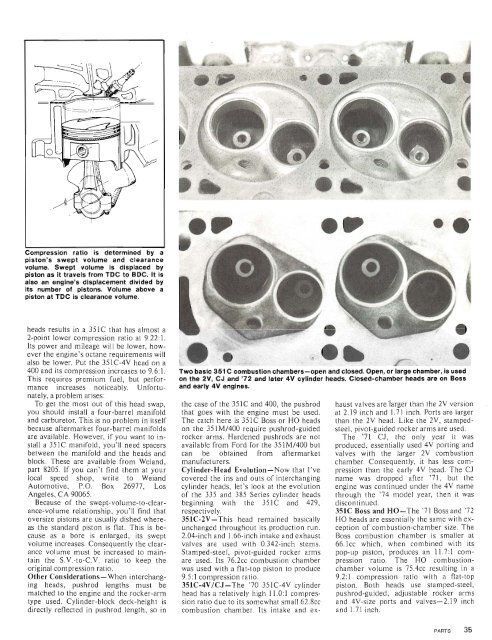How To Rebuild Your Ford V-8 351C-351M-400-429-460.pdf - Index of
How To Rebuild Your Ford V-8 351C-351M-400-429-460.pdf - Index of
How To Rebuild Your Ford V-8 351C-351M-400-429-460.pdf - Index of
You also want an ePaper? Increase the reach of your titles
YUMPU automatically turns print PDFs into web optimized ePapers that Google loves.
PARTS 35<br />
Compression ratio is determined by a<br />
piston's swept volume and clearance<br />
volume. Swept volume is displaced by<br />
piston as it travels from TDC to BDC. It is<br />
also an engine's displacement divided by<br />
its number <strong>of</strong> pistons. Volume above a<br />
piston at TDC is clearance volume.<br />
heads results in a <strong>351C</strong> that has almost a<br />
2-point lower compression ratio at 9.22:l.<br />
Its power and mileage will be lower, however<br />
the engine's octane requirements will<br />
also be lower. Put the <strong>351C</strong>-4V head on a<br />
<strong>400</strong> and its compression increases to 9.6:l.<br />
This requires premium fuel, but performance<br />
increases noticeably. Unfortunately,<br />
a problem arises:<br />
<strong>To</strong> get the most out <strong>of</strong> this head swap,<br />
you should install a four-barrel manifold<br />
and carburetor. This is no problem in itself<br />
because aftermarket four-barrel manifolds<br />
are available. <strong>How</strong>ever, if you want to install<br />
a <strong>351C</strong> manifold, you'll need spacers<br />
between the manifold and the heads and<br />
block. These are available from Weiand,<br />
part 8205. If you can't find them at your<br />
local speed shop, write to Weiand<br />
Automotive, P.O. Box 26977, Los<br />
Angeles, CA 90065.<br />
Because <strong>of</strong> the swept-volume-to-clearance-volume<br />
relationship, you'll find that<br />
oversize pistons are usually dished whereas<br />
the standard piston is flat. This is because<br />
as a bore is enlarged, its swept<br />
volume increases. Consequently the clearance<br />
volume must be increased to maintain<br />
the S.V.-to-C.V. ratio to keep the<br />
original compression ratio.<br />
Other Considerations- When interchanging<br />
heads, pushrod lengths must be<br />
matched to the engine and the rocker-arm<br />
type used. Cylinder-block deck-height is<br />
directly reflected in pushrod length, so in<br />
Two bask 351 C combustion chambers-open and closed. Open, or large chamber, is used<br />
on the 2V, CJ and '72 and later 4V cylinder heads. Closed-chamber heads are on Boss<br />
and early 4V engines.<br />
the case <strong>of</strong> the <strong>351C</strong> and <strong>400</strong>, the pushrod<br />
that goes with the engine must be used.<br />
The catch here is <strong>351C</strong> Boss or HO heads<br />
on the <strong>351M</strong>l<strong>400</strong> require pushrod-guided<br />
rocker arms. Hardened pushrods are not<br />
available from <strong>Ford</strong> for the <strong>351M</strong>l<strong>400</strong> but<br />
can be obtained from aftermarket<br />
manufacturers.<br />
Cylinder-Head Evolution-Now that I've<br />
covered the ins and outs <strong>of</strong> interchanging<br />
cylinder heads, let's look at the evolution<br />
<strong>of</strong> the 335 and 385 Series cylinder heads<br />
beginning with the <strong>351C</strong> and <strong>429</strong>,<br />
respectively.<br />
<strong>351C</strong>-2V-This head remained basically<br />
unchanged throughout its production run.<br />
2.04-inch and 1.66-inch intake and exhaust<br />
valves are used with 0.342-inch stems.<br />
Stamped-steel, pivot-guided rocker arms<br />
are used. Its 76.2~~<br />
combustion chamber<br />
was used with a flat-top piston to produce<br />
9.5:l compression ratio.<br />
<strong>351C</strong>-4V/CJ-The '70 <strong>351C</strong>-4V cylinder<br />
head has a relatively high 11.0:l compression<br />
ratio due to its somewhat small 62.8~~<br />
combustion chamber. Its intake and ex-<br />
haust valves are'l'arger than the 2V version<br />
at 2.19 inch and 1.71 inch. Ports are larger<br />
than the 2V head. Like the 2V, stampedsteel,<br />
pivot-guided rocker arms are used.<br />
The '71 CJ, the only year it was<br />
produced, essentially used 4V porting and<br />
valves with the larger 2V combustion<br />
chamber. Consequently, it has less compression<br />
than the early 4V head. The CJ<br />
name was dropped after '71, but the<br />
engine was continued under the 4V name<br />
through the '74 model year, then it was<br />
discontinued.<br />
<strong>351C</strong> Boss and HO-The '71 Boss and '72<br />
HO heads are essentially the same with exception<br />
<strong>of</strong> combustion-chamber size. The<br />
Boss combustion chamber is smaller at<br />
66.lcc which, when combined with its<br />
pop-up piston, produces an 11.7:l compression<br />
ratio. The HO combustion-<br />
chamber volume is 75.4~~ resulting in a<br />
9.2:l compression ratio with a flat-top<br />
piston. Both heads use stamped-steel,<br />
pushrod-guided, adjustable rocker arms<br />
and 4V-size ports and valves-2.19<br />
and 1.71 inch.<br />
inch
















